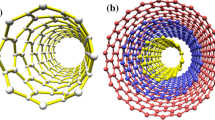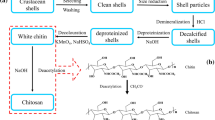Abstract
This work describes the preparation and use of a polydimethylsiloxane sponge amino functionalized for the adsorption of copper in water. The sponge was structurally characterized by infrared spectroscopy and solid-state 29Si NMR, which indicated the presence of silsesquioxane units that acted as nodes on the PDMS chains and linked the functional groups to the network. Thermogravimetric analysis of the product showed good thermal stability, with the initial temperature of weight loss at 400 °C. The material displayed a high degree of swelling in polar solvent, presumably due the cavities. The presence of the amino group increases the adsorption of copper onto the surface of the sponge, with adsorption capacity of about 2.0 mmol (127 mg) per gram of material. The sponge shows promising results for environmental remediation with the removal of copper in water, as well as a simple utilization with no need of a separation process after metal adsorption.

Highlights
-
A polydimethylsiloxane sponge functionalized with amino groups was prepared.
-
Through a single step preparation process.
-
Adsorption equilibrium are reached after 72 h immersion in aqueous solution.
-
Copper ions was absorbed efficiently from water solution, on the sponge.
-
High adsorption capacities in aqueous media.






Similar content being viewed by others
References
Mi HY, Jing X, Huang HX, Turng LS (2018) Novel polydimethylsiloxane (PDMS) composites reinforced with three-dimensional continuous silica fibers. Mater Lett. 210:173–176. https://doi.org/10.1016/j.matlet.2017.09.018
Gökaltun A, Kang YB, Yarmush ML et al. (2019) Simple Surface Modification of Poly(dimethylsiloxane) via Surface Segregating Smart Polymers for Biomicrofluidics. Sci Rep. 9:7377. https://doi.org/10.1038/s41598-019-43625-5
Oktay B, Kayaman-Apohan N (2013) Polydimethylsiloxane (PDMS)-based antibacterial organic-inorganic hybrid coatings. J Coat Technol Res 10:785–798. https://doi.org/10.1007/s11998-013-9505-3
Wolf MP, Salieb-Beugelaar GB, Hunziker P (2018) PDMS with designer functionalities—properties, modifications strategies, and applications. Prog Polym Sci 83:97–134. https://doi.org/10.1016/j.progpolymsci.2018.06.001
A R, M K, U Š (2017) Kinetic study of thermal degradation of polydimethylsiloxane: the effect of molecular weight on thermal stability in inert atmosphere. Polym Sci 03:6–11. https://doi.org/10.4172/2471-9935.100024
Lee JD (1999) Química inorgânica não tão concisa. Ed Edgard Blucher 5:202–266. ed.
José NM, Prado LAS, de A (2005) Materiais híbridos orgânico-inorgânicos: preparação e algumas aplicações. Quim Nova 28:281–288. https://doi.org/10.1590/S0100-40422005000200020
Krysztafkiewicz A, Jesionowski T, Binkowski S (2000) Precipitated silicas modified with 3-aminopropyltriethoxysilane. Colloids Surf A Physicochem Eng Asp 173:73–84. https://doi.org/10.1016/S0927-7757(00)00632-4
Dhanapal V, Subramanian K (2014) Recycling of reactive dye using semi-interpenetrating polymer network from sodium alginate and isopropyl acrylamide. J Appl Polym Sci 131:1–15. https://doi.org/10.1002/app.40968
Kherroub DE, Boulaouche T (2020) Maghnite: novel inorganic reinforcement for single-step synthesis of PDMS nanocomposites with improved thermal, mechanical and textural properties. Res Chem Intermed 46:5199–5217. https://doi.org/10.1007/s11164-020-04257-x
Demirel G, Çakmak M, Çaykara T, Ellialtioǧlu Ş (2007) Chemisorption of 3-aminopropyltrimethoxysilane on Si(001)-(2 × 2). J Phys Chem C 111:15020–15025. https://doi.org/10.1021/jp073954l
Hiratsuka RS, Santilli CV, Pulcinelli SH (1995) O processo sol-gel: uma visão físico-química. Quim Nova 18:171–180
Reitzmann A, Patcas FC, Kraushaar-Czarnetzki B (2006) Keramische Schwämme—Anwendungspotenzial monolithischer Netzstrukturen als katalytische Packungen. Chem Ing Tech 78:885–898. https://doi.org/10.1002/cite.200600029
Perlich J, Kaune G, Memesa M et al. (2009) Sponge-like structures for application in photovoltaics. Philos Trans R Soc A Math Phys Eng Sci 367:1783–1798. https://doi.org/10.1098/rsta.2009.0017
Choi SJ, Kwon TH, Im H et al. (2011) A polydimethylsiloxane (PDMS) sponge for the selective absorption of oil from water. ACS Appl Mater Interfaces 3:4552–4556. https://doi.org/10.1021/am201352w
Nam YS, Yoon JJ, Park TG (2000) A novel fabrication method of macroporous biodegradable polymer scaffolds using gas foaming salt as a porogen additive. J Biomed Mater Res 53:1–7. https://doi.org/10.1002/(SICI)1097-4636(2000)53:1<1::AID-JBMI3.0.CO;2-R
Guan Y, Cheng F, Pan Z (2019) Superwetting polymeric three dimensional (3D) porous materials for Oil/Water separation: A review. Polymers (Basel) 11. https://doi.org/10.3390/polym11050806
Jha A, Kss S, Chowdhury SR (2017) Advancement of Oil / Water Separating. Mater: Merits Demerits Real-Time Appl 1:1–7. https://doi.org/10.15406/mojps.2017.01.00003
Ke Q, Jin Y, Jiang P, Yu J (2014) Oil/water separation performances of superhydrophobic and superoleophilic sponges. Langmuir 30:13137–13142. https://doi.org/10.1021/la502521c
Wang G, Uyama H (2016) Facile synthesis of flexible macroporous polypropylene sponges for separation of oil and water. Sci Rep 6:21265. https://doi.org/10.1038/srep21265
Li K, Zeng X, Li H, Lai X (2014) Facile fabrication of a robust superhydrophobic/superoleophilic sponge for selective oil absorption from oily water. RSC Adv 4:23861–23868. https://doi.org/10.1039/c4ra01227e
Wang CF, Lin SJ (2013) Robust Superhydrophobic/superoleophilic sponge for effective continuous absorption and expulsion of oil pollutants from Water. ACS Appl Mater Interfaces 5:8861–8864. https://doi.org/10.1021/am403266v
Zhao X, Li L, Li B et al. (2014) Durable superhydrophobic/superoleophilic PDMS sponges and their applications in selective oil absorption and in plugging oil leakages. J Mater Chem A 2:18281–18287. https://doi.org/10.1039/c4ta04406a
Yu C, Yu C, Cui L, et al (2016) Facile Preparation of the Porous PDMS Oil-Absorbent for Oil/Water Separation. 1–6. https://doi.org/10.1002/admi.201600862
Emik S (2014) Preparation and characterization of an IPN type chelating resin containing amino and carboxyl groups for removal of Cu(II) from aqueous solutions. React Funct Polym 75:63–74. https://doi.org/10.1016/j.reactfunctpolym.2013.12.006
Pissetti FL, Araújo PL, de, Silva FAB, Poirier GY (2014) Synthesis of poly(dimethylsiloxane) networks functionalized with imidazole or benzimidazole for copper(ii) removal from water. J Braz Chem Soc 26:1–7. https://doi.org/10.5935/0103-5053.20140264
Ko YG, Lee HJ, Oh HC, Choi US (2013) Cu2+ sequestration by amine-functionalized silica nanotubes. J Hazard Mater 260:489–497. https://doi.org/10.1016/j.jhazmat.2013.06.005
Lu X, Yin Q, Xin Z et al. (2011) Synthesis of poly(aminopropyl/methyl)silsesquioxane particles as effective Cu(II) and Pb(II) adsorbents. J Hazard Mater 196:234–241. https://doi.org/10.1016/j.jhazmat.2011.09.020
Chen D, Wang L, Ma Y, Yang W (2016) Super-adsorbent material based on functional polymer particles with a multilevel porous structure. NPG Asia Mater 8:e301. https://doi.org/10.1038/am.2016.117
Hu Z, Zhang X, Zhang D, Wang JX (2012) Adsorption of Cu2+ on amine-functionalized mesoporous silica brackets. Water Air Soil Pollut 223:2743–2749. https://doi.org/10.1007/s11270-011-1063-7
Chen JH, Huang YH (2016) Efficient adsorption of copper ion from aqueous solution by amino-functioned porous eggshell membrane. Desalin Water Treat 57:12178–12191. https://doi.org/10.1080/19443994.2015.1049555
Guo X, Du B, Wei Q et al. (2014) Synthesis of amino functionalized magnetic graphenes composite material and its application to remove Cr(VI), Pb(II), Hg(II), Cd(II) and Ni(II) from contaminated water. J Hazard Mater 278:211–220. https://doi.org/10.1016/j.jhazmat.2014.05.075
Hokkanen S, Repo E (2014) Adsorption of Ni (II), Cu (II) and Cd (II) from aqueous solutions by amino modified nanostructured microfibrillated cellulose. 1471–1487. https://doi.org/10.1007/s10570-014-0240-4
Favre E (1996) Swelling of crosslinked polydimethylsiloxane networks by pure solvents: Influence of temperature. Eur Polym J 32:1183–1188. https://doi.org/10.1016/S0014-3057(96)00062-6
Prenesti E, Daniele PG, Toso S (2002) Visible spectrophotometric determination of metal ions: the influence of structure on molar absorptivity value of copper(II) complexes in aqueous solution. Anal Chim Acta 459:323–336. https://doi.org/10.1016/S0003-2670(02)00135-6
Giusto, L. A. dos R. Esponja de poli(dimetilsiloxano) funcionalizada com grupo amino para adsorção de metais em meio aquoso. Doctor of Philosophy in Chemistry thesis. Alfenas Federal University. 2019.
Peña-Alonso R, Rubio F, Rubio J (2005) The role of γ -Aminopropyltriethoxysilane (γ -APS) on thermal stability of TEOS-PDMS ormosils. J Sol-Gel Sci Technol 36:77–85. https://doi.org/10.1007/s10971-005-3408-4
Hernández CS, Hernández MS, Cerritos RC et al. (2017) DBTL as neutral catalyst on TEOS/PDMS anticorrosive coating. J Sol-Gel Sci Technol 81:405–412. https://doi.org/10.1007/s10971-016-4198-6
Cesaria M, Arima V, Manera MG, Rella R (2018) Protocol of thermal aging against the swelling of poly(dimethylsiloxane) and physical insight in swelling regimes. Polymer139:145–154. https://doi.org/10.1016/j.polymer.2018.02.022
Zhang X, Ye H, Xiao B et al. (2010) Sol-gel preparation of PDMS/silica hybrid antireflective coatings with controlled thickness and durable antireflective performance. J Phys Chem C 114:19979–19983. https://doi.org/10.1021/jp106192z
Lancastre JJH, Fernandes N, Margaça FMA et al. (2012) Study of PDMS conformation in PDMS-based hybrid materials prepared by gamma irradiation. Radiat Phys Chem 81:1336–1340. https://doi.org/10.1016/j.radphyschem.2012.02.016
González-Rivera J, Iglio R, Barillaro G et al. (2018) Structural and Thermoanalytical Characterization of 3D Porous PDMS Foam Materials: The Effect of Impurities Derived from a Sugar Templating Process. Polym (Basel) 10:616. https://doi.org/10.3390/polym10060616
Silva FAB, Chagas-Silva FA, Florenzano FH, Pissetti FL (2016) Poly(dimethylsiloxane) and Poly[vinyltrimethoxysilane- co -2-(dimethylamino) ethyl methacrylate] Based Cross-Linked Organic-Inorganic Hybrid Adsorbent for Copper(II) Removal from Aqueous Solutions. J Braz Chem Soc 27:2181–2191. https://doi.org/10.5935/0103-5053.20160110.
Glaser RH, Wilkes GL, Bronnimann CE (1989) Solid-state 29Si NMR of TEOS-based multifunctional sol-gel materials. J Non Cryst Solids 113:73–87. https://doi.org/10.1016/0022-3093(89)90320-7
Liu L, Chen J, Zhang W et al. (2020) Graphene oxide/polydimethylsiloxane composite sponge for removing Pb(ii) from water. RSC Adv 10:22492–22499. https://doi.org/10.1039/d0ra03057k
Abdelhafeez IA, Zhou X, Yao Q et al. (2020) Multifunctional edge-activated carbon nitride nanosheet-wrapped polydimethylsiloxane sponge skeleton for selective oil absorption and photocatalysis. ACS Omega 5:4181–4190. https://doi.org/10.1021/acsomega.9b03994
Ng Lee J, Park C, Whitesides GM (2003) SolvenT Compatibility of Poly(dimethylsiloxane)-based Microfluidic Devices. Anal Chem 75:6544–6554. https://doi.org/10.1021/ac0346712
Kappert EJ, Raaijmakers MJT, Tempelman K et al. (2019) Swelling of 9 polymers commonly employed for solvent-resistant nanofiltration membranes: a comprehensive dataset. J Memb Sci 569:177–199. https://doi.org/10.1016/j.memsci.2018.09.059
Boucher EA (1976) Porous materials: structure, properties and capillary phenomena. J Mater Sci 11:1734–1750. https://doi.org/10.1007/BF00737529
Peng W, Xie Z, Cheng G et al. (2015) Amino-functionalized adsorbent prepared by means of Cu(II) imprinted method and its selective removal of copper from aqueous solutions. J Hazard Mater 294:9–16. https://doi.org/10.1016/j.jhazmat.2015.03.046
Yang G, Jiang H (2014) Amino modification of biochar for enhanced adsorption of copper ions from synthetic wastewater. Water Res 48:396–405. https://doi.org/10.1016/j.watres.2013.09.050
Mahaninia MH, Rahimian P, Kaghazchi T (2015) Modified Activated carbons with amino groups and their copper adsorption properties in aqueous solution. Chin J Chem Eng 23:50–56. https://doi.org/10.1016/j.cjche.2014.11.004
Samiey B, Cheng CH, Wu J (2014) Organic-inorganic hybrid polymers as adsorbents for removal of heavy metal ions from solutions: a review. Materials 7:673–726. https://doi.org/10.3390/ma7020673
Da’na E, Sayari A (2011) Adsorption of copper on amine-functionalized SBA-15 prepared by co-condensation: Equilibrium properties. Chem Eng J 166:445–453. https://doi.org/10.1016/j.cej.2010.11.016
Faghihian H, Nourmoradi H, Shokouhi M (2014) Removal of copper (II) and nickel (II) from aqueous media using silica aerogel modified with amino propyl triethoxysilane as an adsorbent: equilibrium, kinetic, and isotherms study. Desalin Water Treat 52:305–313. https://doi.org/10.1080/19443994.2013.785367
Bonesio M, de R, Pissetti FL (2020) Magnetite particles covered by amino-functionalized poly(dimethylsiloxane) network for copper(II) adsorption from aqueous solution. J Sol-Gel Sci Technol 94:154–164. https://doi.org/10.1007/s10971-019-05154-5
Pissetti, FL., Giusto, LA. dos R. Esponja de polidimetilsiloxano funcionalizada, processo e aplicação. BR 10 2018 076101 3, Publication date: 24/04/2019.
Acknowledgements
The authors are grateful to FAPEMIG, CNPq and CAPES for the fellowship granted, and for the provision of financial support. We also thank Ana Cristina Honorato Castro and the Multiuser Laboratory of Chemistry Institute at the Universidade Federal de Uberlândia for the use of the scanning electron microscopy facilities.
Author information
Authors and Affiliations
Corresponding author
Ethics declarations
Conflict of interest
The authors declare no competing interests.
Additional information
Publisher’s note Springer Nature remains neutral with regard to jurisdictional claims in published maps and institutional affiliations.
Rights and permissions
About this article
Cite this article
Giusto, L.A.R., Pissetti, F.L. Polydimethylsiloxane amino functionalized sponge for adsorption of copper in water. J Sol-Gel Sci Technol 99, 243–251 (2021). https://doi.org/10.1007/s10971-021-05538-6
Received:
Accepted:
Published:
Issue Date:
DOI: https://doi.org/10.1007/s10971-021-05538-6




